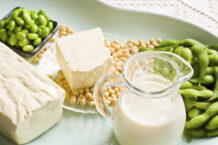Plant-based milk has long been a mainstay for people who avoid cow’s milk for health, environmental, or animal welfare reasons, but they can’t be the only ones enjoying these beverages. According to the food industry news source, Food Navigator, U.S. consumers spent nearly $2.3 billion on plant-based milk in the 52-week period ending in June 2022.
Almond milk is the most popular of these nondairy options, but the competition is fierce, with choices that include old-timers made from soy and rice as well as less familiar beverages made from peas, hemp, quinoa, chia and flax seeds, and even bananas, tiger nuts, and potatoes.
Despite their different main ingredients, most plant milks are made using the same two methods: wet processing and dry processing, both of which produce a product that consists largely of water followed by the dominant plant-based ingredient. Many of these beverages also contain added sugar or some other form of sweetener, as well as added vitamins and minerals (typically vitamin A, vitamin D, and calcium in amounts that often match or surpass the amount in fortified cow’s milk), flavorings, gums, preservatives, and sundry other ingredients.
With the exception of soy milk, however, none of these milk wannabees come close to matching the protein content of cow’s milk unless protein is added (often as pea protein)—but all pose less of an environmental threat than cow’s milk, because cows are one of the biggest methane producers on the planet. Methane is a greenhouse gas that is a major contributor to global climate change, and choosing any plant milk over cow’s milk is vastly better from an environmental perspective. Still, that doesn’t mean plant milks don’t leave a carbon footprint themselves in terms of water and land usage, for example, and there is no clear environmental winner among them. In particular, the production of almond milk requires a lot of water.
The top 5
If you’re ready to make the switch to a nondairy beverage, or you just want more information about what’s out there, here’s a head start, beginning with the top five sellers in the U.S. from June 2021 to June 2022.
- Almond milk. Almost all the nutritional value of store-bought almond milk (as with many other plant-based milks) comes from added ingredients, such as vitamins and minerals, rather than almonds themselves. In fact, the images on the front package of two popular brands, Silk and Almond Breeze, are quite transparent about how many almonds (four!) it takes to make a 1-cup serving of their products—presumably the result of the companies’ being accused of false advertising. You can make your own almond milk by blending 3 tablespoons of almond butter with 1½ cups of water or 1 cup of raw almonds (pre-soaked if you don’t have a high-speed blender) with 3 cups of water, but this more robust-tasting, protein-rich beverage will also contain significantly more calories (primarily from fat) and less calcium than most store-bought brands.
- Oat milk. In addition to water, oats, and usually a variety of lesser ingredients, some oat milk brands contain a little fiber (about 2-3 grams per serving), and some actually add fat (such as from sunflower or canola oil). For instance, a 1-cup serving of Oatly’s “full fat” chilled product and Planet Oat’s “extra creamy original” have 9 and 3.5 grams of total fat, respectively (but just 1 and 0.5 grams of saturated fat). Some unsweetened oat milks also contain a surprising amount of sugar (more than that found in several cups of uncooked oats), which is due to the action of enzymes that convert oat starch into simple sugars such as maltose and glucose. Previously, oat milk manufacturers (including Oatly) that use enzymes to hydrolyze starch into sugars claimed that their products contained “no added sugar,” but in 2019 they agreed to list them as “added sugars” on their Nutrition Facts panels. Some oat milks, such as Califia Farms, are truly sugar free, however.
- Soy milk. Once the market leader, soy milk placed third in U.S. sales. This drop-off is due in part to increased competition and alternatives that taste better to many people, but negative publicity about soy—once a nutrition darling—has also played a big part in soy milk’s faltering market performance. The controversy about soy has largely centered on whether it promotes breast cancer (the American Cancer Society says it does not) but also includes fear of GMO foods (most of the soybeans grown in the U.S. are genetically modified) and its allergenicity (soybeans are one of the “big nine” food allergens). Still, soy milk is the only plant-based milk that matches or exceeds the amount of complete protein in cow’s milk, and it tends to be less expensive than many other types of milk alternatives. It’s also widely available in organic varieties for those who want to avoid GMOs and pesticides, both of which are prohibited in the production of organic foods.
- Coconut milk. The second ingredient after water in two prominent brands (SO Delicious, Silk) is coconut cream, which is made by heating shredded coconut meat in water and then separating the thicker, creamy layer from the watery one. Standout drawbacks of coconut milk are a complete lack of protein and fiber, as well as a relatively high amount of saturated fat (about 4-4.5 grams, or 20-23 percent of the daily recommended limit per cup). If you like the sweet tropical taste of coconut milk but are on a budget, consider making your own by adding canned coconut cream (a relatively inexpensive product) to water. Note that coconut milk beverages are different from higher-calorie, higher-fat canned coconut milks, which are not for drinking straight up but rather are used in small amounts in cooking.
- Pea milk. Commercial pea milk typically consists of water, pea protein extracted from yellow peas, sugar, and vegetable oil (such as sunflower oil), plus some vitamins and minerals, thickeners, and other additives. The Ripple brand, founded in 2015, dominates the category. In addition to its Ripple Original, the company sells several flavored varieties and a product for children, along with protein shakes and half-and-half. NotCo, a company that also launched in 2015, claims to have harnessed the power of artificial intelligence (AI) to help them create NOTMILK, which comes in unflavored 1%, 2%, and whole varieties. According to NotCo, its AI program—called Giuseppe—came up with the best formulations by analyzing the “structure” of cow’s milk “at a molecular level” and then testing “infinite combinations of plant-based goodness” to replicate its flavor and texture. Okay, but a glance at the ingredients in NOTMILK reveals that aside from very small amounts of pineapple and cabbage juice concentrate, NOTMILK’s constituents are NOTVERY different from other plant milks on the market. And if protein is of paramount importance to you, note that NOTMILK contains half the amount (4 grams per cup) as Ripple (8 grams).
More plant milk options
- Rice milk. Made from milled rice—either fully milled (i.e., white rice) or partially milled (i.e., brown rice)—this plant-based beverage consists mostly of carbohydrates and is low in fat (none saturated), though vegetable oil may be added, which increases the fat content. Don’t expect much if any protein—or any fiber, even if it’s made from brown rice. Rice milk typically has a thin consistency; it’s naturally sweeter than other nondairy beverages and less likely to cause allergies. There are many commercial brands of rice milk, but it’s easy to make your own additive-free version by blending soaked or cooked rice with water. You can flavor it with vanilla, a little sweetener to taste, or cinnamon.
- Hemp milk. This is made from the seeds of the industrial hemp plant (varieties of Cannabis sativa that are grown for food and textile uses). Hemp milk provides some protein (3-4 grams per cup) and healthy unsaturated fats, including a plant form of omega-3s called alpha-linolenic acid (ALA, also present in walnuts and flaxseed). You won’t get high from hemp milk, however. The plants used are low in THC, the main psychoactive compound in cannabis, and foods made from them contain only trace amounts at most.
- Other nut milks. Name any nut—almonds (discussed above), cashews, hazelnuts, macadamias, pecans, pistachios, walnuts—and there’s likely a commercial nut milk made from it. Unlike nuts themselves, nut milks are relatively low in calories (if unsweetened) and contain little or no saturated fat. That’s because they’re mostly water. The downside is that nut milks supply just small amounts of protein and other nutrients present in nuts, such as vitamin E, manganese, magnesium, and copper, unless the milks are fortified. They also contain little if any fiber (though cow’s milk has none at all).
Shopping tips
There are a lot of plant-based milks on the market these days, both in shelf-stable packaging and refrigerated, but the one(s) you choose will ultimately come down to taste preferences as well as ingredients that you want to include or exclude from your diet for health reasons.
Here are a few tips to help you make that decision.
- Always read the ingredients list. Unlike plain cow’s milk, most of these products contain a long list of ingredients, including thickeners (various gums), preservatives, and sweeteners, that you may want to take into consideration before purchasing. A few, however, contain just water and the namesake ingredient.
- Look at the Nutrition Facts panel, too. It tells you how much protein, carbs (including added sugars), fat (including saturated fat), and vitamins and minerals are in a serving. Note that some products list smaller serving sizes than the standard 1 cup for plant-based milk.
- If you want a nutritional profile similar to that of cow’s milk, look for a fortified product that contains about 8 grams of protein, 15% of the Daily Value (DV) for vitamins A and D, 25% of the DV for calcium, and 8% of the DV for potassium. Some plant milks contain even higher amounts of vitamins and minerals than cow’s milk. Many are also fortified with vitamin B12 (an advantage for vegans who don’t get much B12 in their diets).
- Consider unsweetened versions. You can always add a little sweetener of your choice, but you can’t remove the often-considerable amount of sugar found in some of these beverages (as many as five added teaspoons per cup). Some of the sugars used in them are rice syrup, barley malt, and cane sugar, which may sound healthier than regular sugar but are not. Note that a fair number of plant milks now use low- or no-calorie sweeteners such as stevia, and are thus sugar free and lower in calories.
Note: Whatever plant milk you buy, give it a good shake before drinking. That’s advised because ingredients can separate over time and, in the case of calcium in particular, settle to the bottom of the container.
The issue of whether plant-based milk alternatives can legally be called “milk”—as in “almond milk” and “oat milk”—has been a long-standing and contentious one. In 2018, the FDA requested comments from the public about whether the current federal standard of identity for milk—which limits the word “milk” to the “lacteal secretions of cows”—should be upheld, as it is in other countries, including those in the European Union. As a former commissioner of the FDA stated, “an almond doesn’t lactate.”
It’s not that consumers may mistakenly believe that such plant-derived beverages come from cows (it’s obvious to most people that they don’t), but rather that the word “milk” on the label may mislead people into thinking that these nondairy beverages are nutritionally similar to cow’s milk (which often is not the case). That’s the argument of the dairy industry, which has pushed for these beverages to be relabeled “plant beverages” or the like. In Europe, they are now typically labeled as “drinks.”
If the dairy industry has its way, that could spell trouble for the makers of plant milks, particularly for the company Milkadamia, which includes the word “milk” in its name (and has “Moo is moot” as its tagline). The Plant Based Foods Association (yes, there is one) has fought back. In comments submitted to the FDA back in November 2021, PBFA maintained that consumers understand that plant-based milks don’t come from cows, that the terms are “appropriately descriptive and beneficial to consumers as they inform them about the taste of and uses for the product,” and that the names are so well recognized and commonly used today that they have become part of the lexicon.
This past February, the FDA finally issued draft labeling recommendations, which, in a nutshell, would allow the continued use of the word “milk” on the labels of plant-based milk alternatives, but also advised that companies provide a voluntary nutrient statement that conveys how the product compares to dairy milk (it may, for instance, have less calcium and protein than regular milk if it’s not fortified). The draft guidance led to yet more uproar from both sides of the fence, which consequently led to the FDA reopening its comments period and means further delay in when the final guidelines will be issued.





